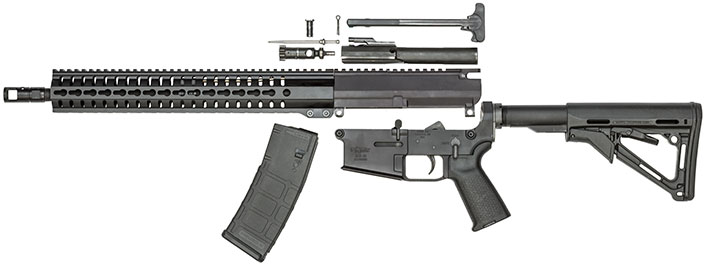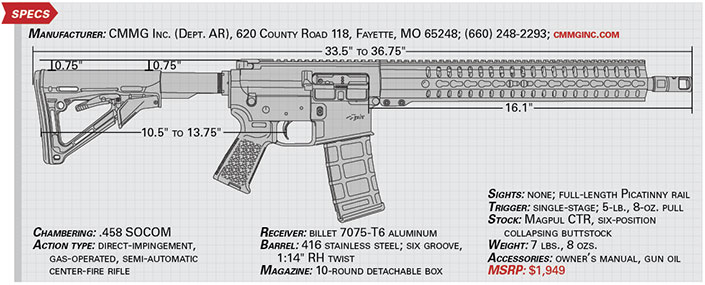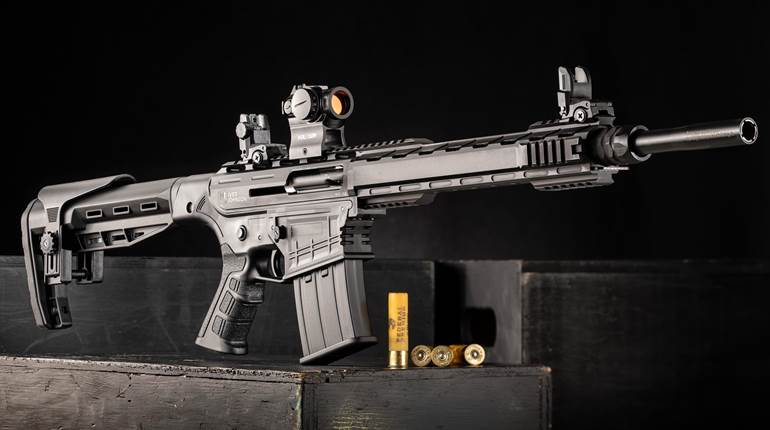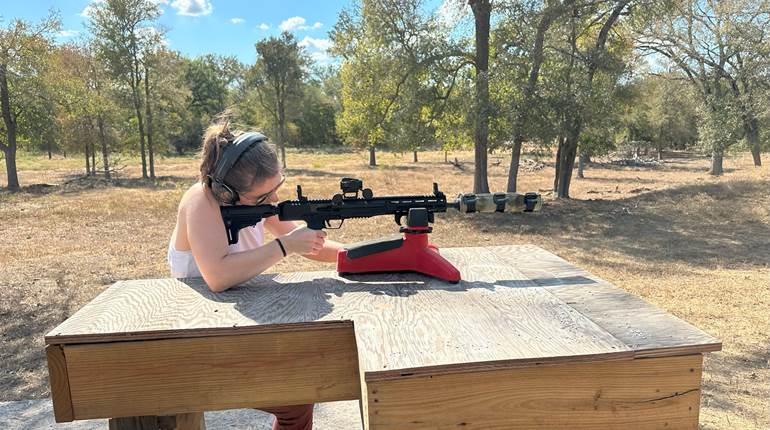
When a firearm is as modular as the AR-15, it is only a matter of time before someone pushes the boundaries to chamber it for a cartridge that maximizes its power potential. The CMMG MkW-15 XBE Anvil, chambered in the potent .458 SOCOM, certainly exemplifies that goal, but does so in an upgraded package better-equipped to handle the cartridge’s geometry. There are no free lunches, though, and the Anvil certainly has its specific quirks.
The .458 SOCOM cartridge was itself designed with the aim of maximizing the terminal performance of the AR-15 receiver and magazine. It was developed by modifying a .50 Action Express handgun case—lengthening it as well as rebating the rim from 0.514" to 0.473" and adding a slight bottleneck to accommodate the 0.458" projectile.
The .458 SOCOM is not a SAAMI-approved cartridge, but rather a proprietary wildcat with copyrighted chamber dimensions. Nonetheless, factory ammunition is available from several sources. The recoil generated by the .458 SOCOM is significant, particularly when fired from a bench rest. The ballistics of this cartridge roughly duplicate those of the .45-70 Gov’t, with bullet weights as heavy as 500 grains: When the bullet mass of a 5.56x45 mm NATO round is multiplied by a factor of five or 10, recoil increases accordingly.
Though the .458 SOCOM was designed to function in the standard AR-15 receiver, its larger case head diameter requires opening up the AR-15’s bolt face. That and increased bolt thrust mean that the cartridge erodes some of the margin for error built into Stoner’s design. On the positive side, the .458 SOCOM operates at significantly lower chamber pressures than does the 5.56/.223. Taking such factors into consideration, CMMG chose its larger Mutant platform for the Anvil. Essentially a shortened AR-10, the Mutant/Anvil’s bolt carrier, bolt body and bolt locking lugs are an average of 23 percent larger than those of a standard AR-15. The Anvil’s larger bolt adds significant mass, and a corresponding safety margin, back into the system.

The controls of the Anvil will be familiar to those accustomed to other ARs, with the charging handle, selector/safety lever and magazine release all located in the traditional positions. Fieldstripping and reassembly procedures for the Anvil are also identical to those of other AR-type carbines. There is no forward assist on the receiver, but the brass deflector is retained behind the ejection port. The magazine well on the Anvil is scaled to accept AR-15 magazines. The billet aluminum receiver is a flat-top design with a Picatinny rail for mounting optics—the Anvil is not equipped from the factory with sights.
The Anvil’s furniture is from Magpul: a six-position CTR stock on the mil-spec buffer tube and an MOE pistol grip, both molded in black. The fore-end is a CMMG RKM15 free-float aluminum tube with a Picatinny rail at the 12-o’clock position and KeyMod slots on the 3-, 6- and 9-o’clock surfaces. The Picatinny rail allows for simple and secure mounting of sights and optics, while the KeyMod interfaces with various accessory mounts for lights, grips, bipods and the like. Despite the use of a carbine-length gas system, the fore-end runs the length of the 16.1" barrel. This extra real estate proved to be beneficial while trying to keep muzzle rise to a minimum during recoil. The Anvil’s SLR gas block is adjustable, allowing the shooter to tune the gas system to the load being used by turning the adjustment hex screw through a corresponding slot in the fore-end. The barrel is threaded 5/8x32 and topped with CMMG’s SV muzzle brake to help tame the rifle’s recoil.
The .458 SOCOM cartridge fits inside a standard AR magazine, albeit in a single column. The CMMG comes with a polymer magazine that has been adapted for use with the .458. So converted, a 30-round 5.56 mm magazine holds 10 rounds of .458. Due to the diameter of the broader .458 SOCOM cartridge, care must be taken when inserting a magazine into the carbine with the bolt locked to the rear. Forcefully inserting the magazine can result in the topmost cartridge releasing from the feed lips and causing a malfunction; the owner’s manual specifically warns against this issue. A shorter magazine would be useful for bench shooting, as the included magazine requires a high rest to provide clearance.
While conducting our range testing of the Anvil, we found that obtaining tight five-shot groups from the bench was a challenge. During more than one string of fire, three rounds would land in a single ragged sub-m.o.a. hole, followed by a round or two that would inexplicably land inches away. Two of the tested ammunition loads produced far better results than the other, with the SBR Performance and Black Butterfly loads producing the most consistently respectable groups. The single-stage trigger broke consistently at 5 lbs., 8 ozs., with moderate creep.

Reliability was less than 100 percent during our testing, with a handful of issues arising. Failures to fire due to light primer strikes were encountered on a few occasions, and were not confined to a single brand of ammunition or load. In addition, we discovered that it was possible for the rebated rim of the top cartridge in the magazine to slip rearward into the notch separating the feed lips. In circumstances where a magazine was inadvertently inserted under this condition, difficult-to-clear stoppages were the result. Otherwise, the carbine fed, fired, extracted and ejected.
The 5.56 mm cartridge is not the answer to every question, and, in situations where greater bullet mass is needed from the AR platform, the Anvil would certainly fit the bill. While the versatility of the AR certainly suffers when pushed to such a ballistic extreme, the raw power cannot be ignored. Although the .458 SOCOM functions in the AR-15, it does so at the dimensional boundaries of a rifle engineered around a much smaller cartridge. The oversized receiver of the CMMG Anvil is, in concept and execution, a superior host for this powerful chambering.







































